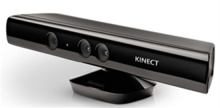Kinect for Windows Available February 1 for $249
 Microsoft has announced that Kinect for Windows will be made available starting less than a month away, on February 1. The hardware and software will release in an array of countries, including the United States, the United Kingdom, Australia, Canada, France, Germany, Ireland, Italy, Japan, Mexico, New Zealand, and Spain, at a suggested U.S. retail price point of $249. If you’re wondering, GameStop is selling a 4 GB Xbox 360 Kinect bundle for only $50 more than the Windows Kinect, at $299.
Microsoft has announced that Kinect for Windows will be made available starting less than a month away, on February 1. The hardware and software will release in an array of countries, including the United States, the United Kingdom, Australia, Canada, France, Germany, Ireland, Italy, Japan, Mexico, New Zealand, and Spain, at a suggested U.S. retail price point of $249. If you’re wondering, GameStop is selling a 4 GB Xbox 360 Kinect bundle for only $50 more than the Windows Kinect, at $299.
That seemingly overly expensive $249 price point includes a one year warranty and access to updates. Microsoft said they are planning to knock $100 off that original tag for Qualified Educational Users later this year, though a specific date hasn’t yet been announced.
Microsoft seems to realize the pricing may throw people, as they spend a few paragraphs explaining the price point of the more-expensive Windows version of their Kinect unit:
The ability to sell Kinect for Xbox 360 at its current price point is in large part subsidized by consumers buying a number of Kinect games, subscribing to Xbox LIVE, and making other transactions associated with the Xbox 360 ecosystem. In addition, the Kinect for Xbox 360 was built for and tested with the Xbox 360 console only, which is why it is not licensed for general commercial use, supported or under warranty when used on any other platform.
Essentially, Microsoft is saying Windows Kinect is more expensive because it makes less money due to a lack of supplemental software sales, but also because more testing goes into the unit. Surprisingly, Microsoft won’t be charging for development kits, making the SDK freely available to developers and end-users.
Of course, the mountain Microsoft faces is if enough people will actually want a Kinect for their computer, especially at the cost of a brand new PlayStation 3 or only $50 less than an Xbox 360 and Kinect bundle. One of the main problems with Kinect on the Xbox 360 is that, oddly, the technology isn’t really there that would help the Kinect make the Xbox 360 experience easier or feel more natural: Shouting at your Xbox until it understands that you said “video” instead of something else, having to hover a limb over a menu selection for too long making your arm tired, and the lag in recognizing the user’s movement. As Apple did with Siri, Microsoft built the foundation of an impressive piece of technology with the Kinect, but the that’s all it really is at the moment — a foundation. With the release of Kinect for Windows, one wonders if people will be willing to sit further back from their computer and put their hands somewhere other than the keyboard and mouse that have treated them so well over the years.
(via Kinect for Windows blog)
- Tape measure art with Kinect
- Kinect-enabled seeing eye robot dog
- Kinect-powered Breakout game uses entire building as screen
Have a tip we should know? [email protected]